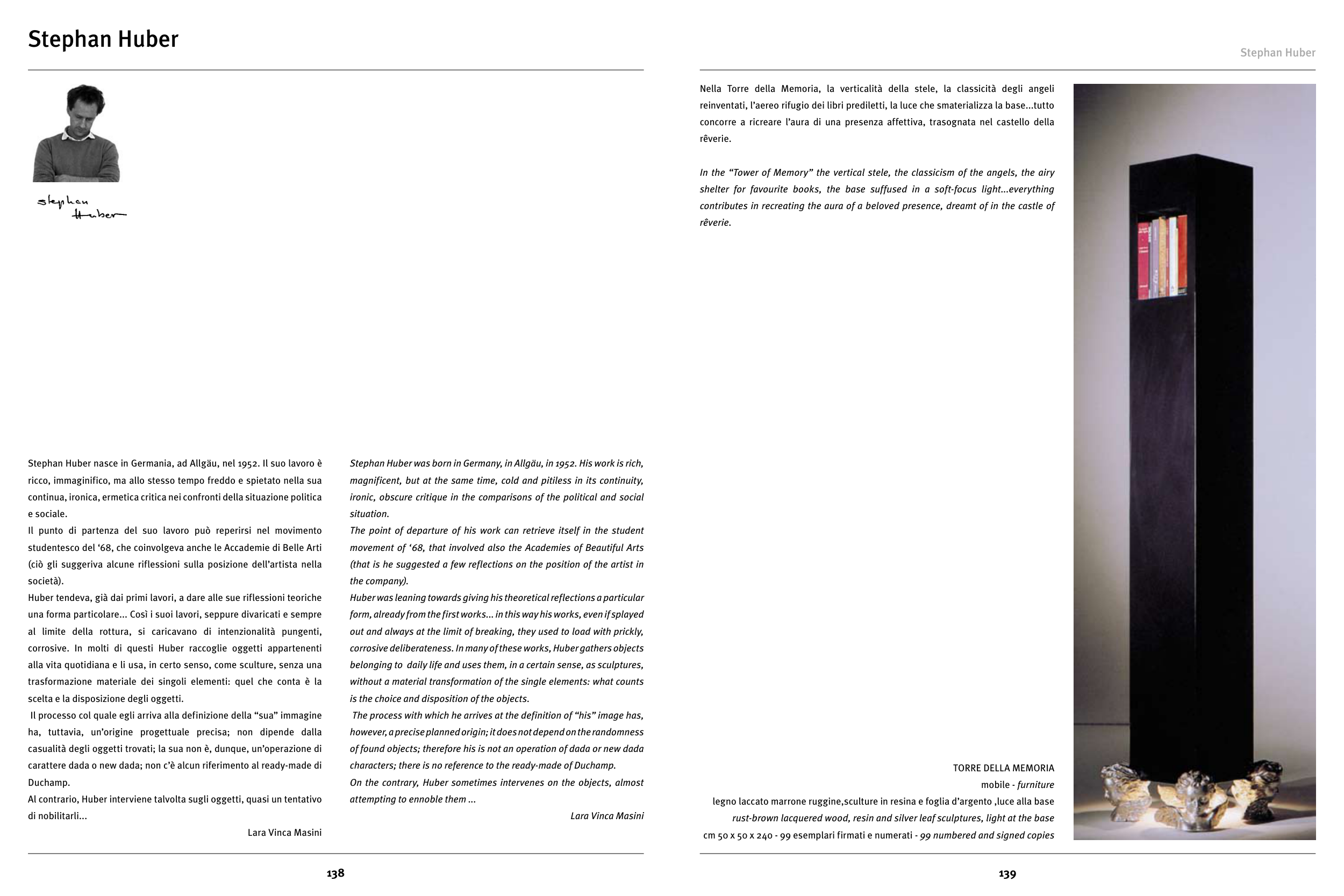TORRE DELLA MEMORIA
mobile - furniture
legno laccato marrone ruggine,sculture in resina e foglia d’argento ,luce alla base
rust-brown lacquered wood, resin and silver leaf sculptures, light at the base
cm 50 x 50 x 240 - 99 esemplari firmati e numerati - 99 numbered and signed copies
Nella Torre della Memoria, la verticalità della stele, la classicità degli angeli
reinventati, l’aereo rifugio dei libri prediletti, la luce che smaterializza la base...tutto
concorre a ricreare l’aura di una presenza affettiva, trasognata nel castello della
rêverie.
In the “Tower of Memory” the vertical stele, the classicism of the angels, the airy
shelter for favourite books, the base suffused in a soft-focus light...everything
contributes in recreating the aura of a beloved presence, dreamt of in the castle of
rêverie.
Stephan Huber
Stephan Huber nasce in Germania, ad Allgäu, nel 1952. Il suo lavoro è
ricco, immaginifico, ma allo stesso tempo freddo e spietato nella sua
continua, ironica, ermetica critica nei confronti della situazione politica
e sociale.
Il punto di partenza del suo lavoro può reperirsi nel movimento
studentesco del ‘68, che coinvolgeva anche le Accademie di Belle Arti
(ciò gli suggeriva alcune riflessioni sulla posizione dell’artista nella
società).
Huber tendeva, già dai primi lavori, a dare alle sue riflessioni teoriche
una forma particolare... Così i suoi lavori, seppure divaricati e sempre
al limite della rottura, si caricavano di intenzionalità pungenti,
corrosive. In molti di questi Huber raccoglie oggetti appartenenti
alla vita quotidiana e li usa, in certo senso, come sculture, senza una
trasformazione materiale dei singoli elementi: quel che conta è la
scelta e la disposizione degli oggetti.
Il processo col quale egli arriva alla definizione della “sua” immagine
ha, tuttavia, un’origine progettuale precisa; non dipende dalla
casualità degli oggetti trovati; la sua non è, dunque, un’operazione di
carattere dada o new dada; non c’è alcun riferimento al ready-made di
Duchamp.
Al contrario, Huber interviene talvolta sugli oggetti, quasi un tentativo
di nobilitarli...
Lara Vinca Masini
Stephan Huber was born in Germany, in Allgäu, in 1952. His work is rich,
magnificent, but at the same time, cold and pitiless in its continuity,
ironic, obscure critique in the comparisons of the political and social
situation.
The point of departure of his work can retrieve itself in the student
movement of ‘68, that involved also the Academies of Beautiful Arts
(that is he suggested a few reflections on the position of the artist in
the company).
Huber was leaning towards giving his theoretical reflections a particular
form, already from the first works... in this way his works, even if splayed
out and always at the limit of breaking, they used to load with prickly,
corrosive deliberateness. In many of these works, Huber gathers objects
belonging to daily life and uses them, in a certain sense, as sculptures,
without a material transformation of the single elements: what counts
is the choice and disposition of the objects.
The process with which he arrives at the definition of “his” image has,
however, a precise planned origin; it does not depend on the randomness
of found objects; therefore his is not an operation of dada or new dada
characters; there is no reference to the ready-made of Duchamp.
On the contrary, Huber sometimes intervenes on the objects, almost
attempting to ennoble them ...
Lara Vinca Masini
Stephan Huber
13�
13�


